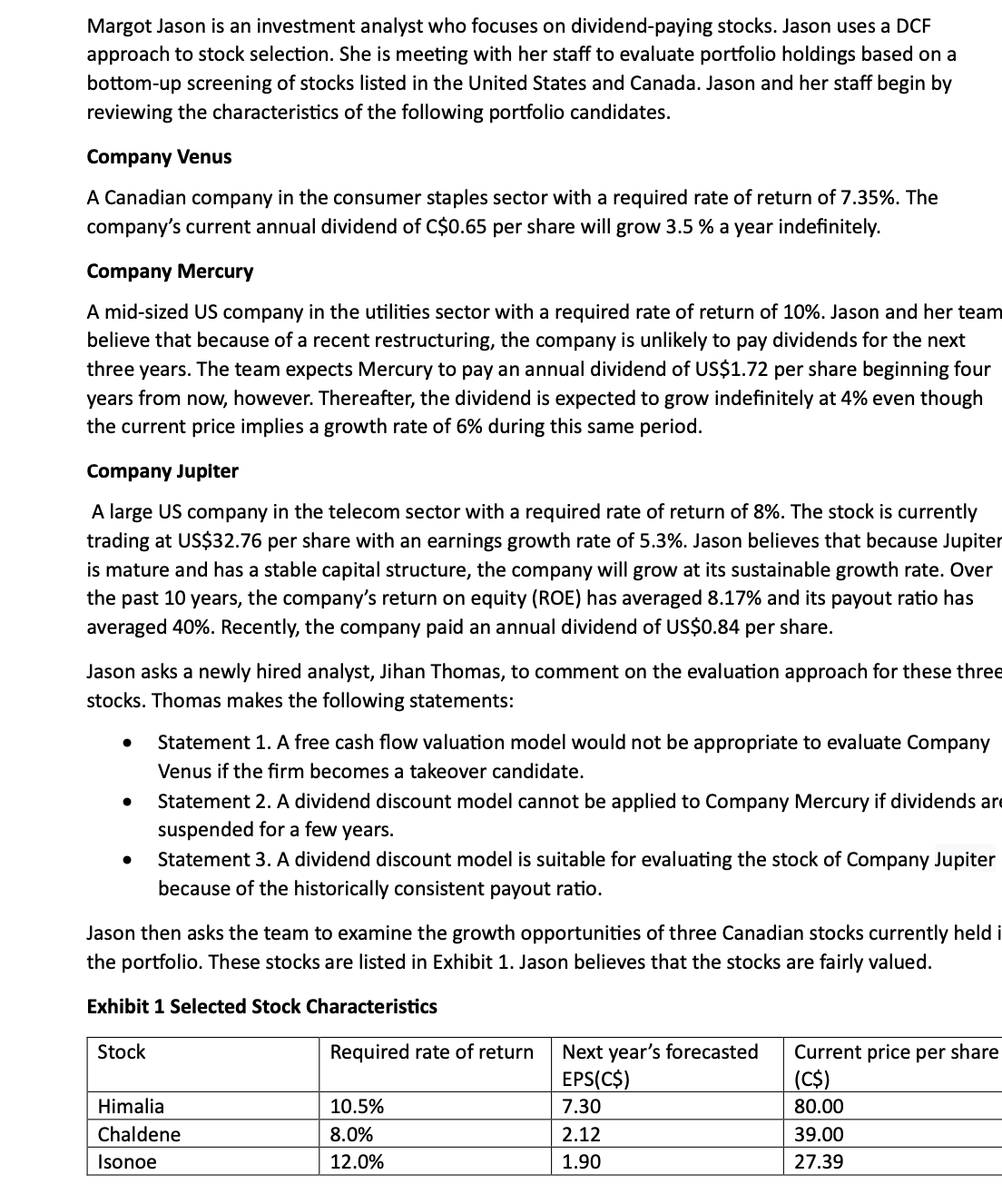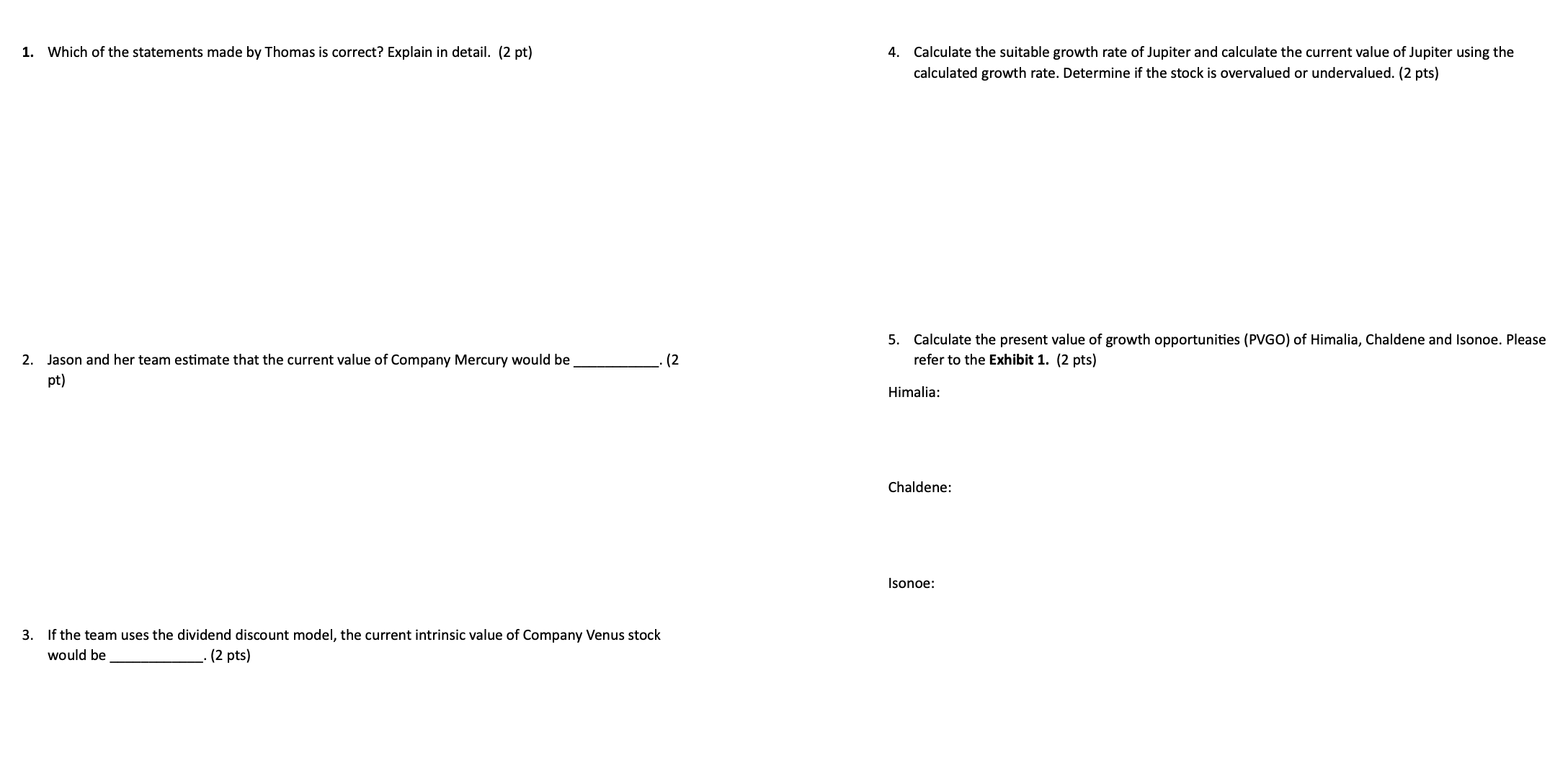Answered step by step
Verified Expert Solution
Question
1 Approved Answer
Margot Jason is an investment analyst who focuses on dividend-paying stocks. Jason uses a DCF approach to stock selection. She is meeting with her staff

 Margot Jason is an investment analyst who focuses on dividend-paying stocks. Jason uses a DCF approach to stock selection. She is meeting with her staff to evaluate portfolio holdings based on a bottom-up screening of stocks listed in the United States and Canada. Jason and her staff begin by reviewing the characteristics of the following portfolio candidates. Company Venus A Canadian company in the consumer staples sector with a required rate of return of 7.35%. The company's current annual dividend of C $0.65 per share will grow 3.5% a year indefinitely. Company Mercury A mid-sized US company in the utilities sector with a required rate of return of 10%. Jason and her team believe that because of a recent restructuring, the company is unlikely to pay dividends for the next three years. The team expects Mercury to pay an annual dividend of US\$1.72 per share beginning four years from now, however. Thereafter, the dividend is expected to grow indefinitely at 4% even though the current price implies a growth rate of 6% during this same period. Company Jupiter A large US company in the telecom sector with a required rate of return of 8%. The stock is currently trading at US\$32.76 per share with an earnings growth rate of 5.3%. Jason believes that because Jupiter is mature and has a stable capital structure, the company will grow at its sustainable growth rate. Over the past 10 years, the company's return on equity (ROE) has averaged 8.17% and its payout ratio has averaged 40%. Recently, the company paid an annual dividend of US\$0.84 per share. Jason asks a newly hired analyst, Jihan Thomas, to comment on the evaluation approach for these three stocks. Thomas makes the following statements: - Statement 1. A free cash flow valuation model would not be appropriate to evaluate Company Venus if the firm becomes a takeover candidate. - Statement 2. A dividend discount model cannot be applied to Company Mercury if dividends ar suspended for a few years. - Statement 3. A dividend discount model is suitable for evaluating the stock of Company Jupiter because of the historically consistent payout ratio. Jason then asks the team to examine the growth opportunities of three Canadian stocks currently held the portfolio. These stocks are listed in Exhibit 1. Jason believes that the stocks are fairly valued. Exhibit 1 Selected Stock Characteristics 1. Which of the statements made by Thomas is correct? Explain in detail. (2 pt) 2. Jason and her team estimate that the current value of Company Mercury would be (2 pt) 4. Calculate the suitable growth rate of Jupiter and calculate the current value of Jupiter using the calculated growth rate. Determine if the stock is overvalued or undervalued. (2 pts) 5. Calculate the present value of growth opportunities (PVGO) of Himalia, Chaldene and Isonoe. Please refer to the Exhibit 1. (2 pts) Himalia: Chaldene: Isonoe: 3. If the team uses the dividend discount model, the current intrinsic value of Company Venus stock would be . (2 pts)
Margot Jason is an investment analyst who focuses on dividend-paying stocks. Jason uses a DCF approach to stock selection. She is meeting with her staff to evaluate portfolio holdings based on a bottom-up screening of stocks listed in the United States and Canada. Jason and her staff begin by reviewing the characteristics of the following portfolio candidates. Company Venus A Canadian company in the consumer staples sector with a required rate of return of 7.35%. The company's current annual dividend of C $0.65 per share will grow 3.5% a year indefinitely. Company Mercury A mid-sized US company in the utilities sector with a required rate of return of 10%. Jason and her team believe that because of a recent restructuring, the company is unlikely to pay dividends for the next three years. The team expects Mercury to pay an annual dividend of US\$1.72 per share beginning four years from now, however. Thereafter, the dividend is expected to grow indefinitely at 4% even though the current price implies a growth rate of 6% during this same period. Company Jupiter A large US company in the telecom sector with a required rate of return of 8%. The stock is currently trading at US\$32.76 per share with an earnings growth rate of 5.3%. Jason believes that because Jupiter is mature and has a stable capital structure, the company will grow at its sustainable growth rate. Over the past 10 years, the company's return on equity (ROE) has averaged 8.17% and its payout ratio has averaged 40%. Recently, the company paid an annual dividend of US\$0.84 per share. Jason asks a newly hired analyst, Jihan Thomas, to comment on the evaluation approach for these three stocks. Thomas makes the following statements: - Statement 1. A free cash flow valuation model would not be appropriate to evaluate Company Venus if the firm becomes a takeover candidate. - Statement 2. A dividend discount model cannot be applied to Company Mercury if dividends ar suspended for a few years. - Statement 3. A dividend discount model is suitable for evaluating the stock of Company Jupiter because of the historically consistent payout ratio. Jason then asks the team to examine the growth opportunities of three Canadian stocks currently held the portfolio. These stocks are listed in Exhibit 1. Jason believes that the stocks are fairly valued. Exhibit 1 Selected Stock Characteristics 1. Which of the statements made by Thomas is correct? Explain in detail. (2 pt) 2. Jason and her team estimate that the current value of Company Mercury would be (2 pt) 4. Calculate the suitable growth rate of Jupiter and calculate the current value of Jupiter using the calculated growth rate. Determine if the stock is overvalued or undervalued. (2 pts) 5. Calculate the present value of growth opportunities (PVGO) of Himalia, Chaldene and Isonoe. Please refer to the Exhibit 1. (2 pts) Himalia: Chaldene: Isonoe: 3. If the team uses the dividend discount model, the current intrinsic value of Company Venus stock would be . (2 pts) Step by Step Solution
There are 3 Steps involved in it
Step: 1

Get Instant Access to Expert-Tailored Solutions
See step-by-step solutions with expert insights and AI powered tools for academic success
Step: 2

Step: 3

Ace Your Homework with AI
Get the answers you need in no time with our AI-driven, step-by-step assistance
Get Started


